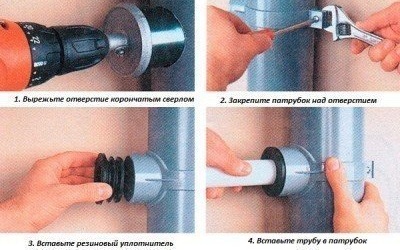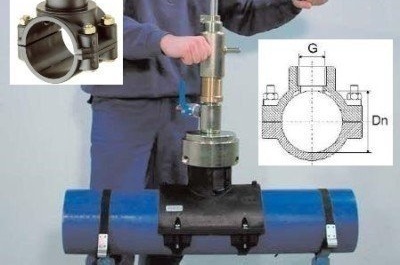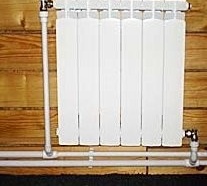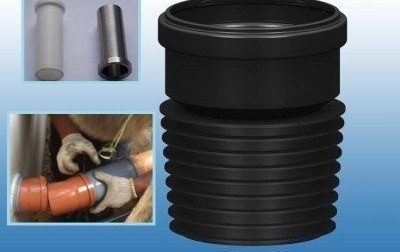Inserting into a plastic pipe without welding using nozzles, saddles and special adapters
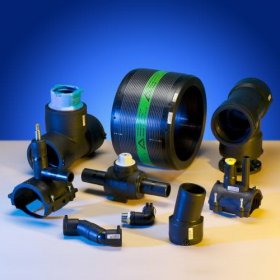
A private house or a summer house throughout the entire period of operation is being rebuilt, improved, equipped. Sometimes these manipulations are forced, due to the wear of any structure or system, and sometimes there is a desire to upgrade them to increase comfort in the house. But, whatever the underlying causes of the process, sometimes such an operation as cutting into a pipe without welding becomes relevant. For example, without this procedure, it is impossible to organize an additional sewer drain during the installation of the washing machine, or vice versa, the creation of an additional drainage point for connecting the household appliance to the water supply system.
Outline the circle of tasks
If you need an insert into a water pipe, for example, then the most logical at first glance would be a very simple way:
- The pipe is cut.
- A tee is welded in or inserted.
- Connection to the tee is in progress.
If you have to deal with the plumbing or heating pipe yet another “Soviet knockout,” that is, metal, then such a “forehead to forehead” type of manipulation is a very effective way to solve the problem. But such pipes in practice are found less and less, they are ruthlessly and everywhere ousted by systems from plastic and its derivatives. Therefore, today the question of how to crash into a plastic pipe will be more relevant.
Naturally, this work is not as simple as it seems at first glance, although, on the other hand, a layman can also cope with it if he is armed with our advice, and will also show diligence and will. And for starters, you need to understand the amount of work that will have to face.
Possible problems when inserting:
- The pipe is sawn and in the right place a piece under the tee is cut very precisely in size. It should be borne in mind that the pipe can very closely adjoin the wall surface, and it can also be half-walled into the wall.
- You may need to join on the basis of the "father-mother." The end of each pipe is equipped with an extension - a bell in which there is a rubber seal. It is in this socket that another pipe will have to be inserted.
- Also, most likely, it will be necessary to replace one whole pipe with two smaller ones. And between them it will be necessary to carry out the installation of a pipe segment with a pipe through which the connection will be made.
Insertion into a water supply system by means of a branch pipe
In fact, the answer to the question of how to crash into a water pipe can be very simple. One of the methods of this process does not require cutting a pipe element. To begin with, a piece of pipe with a pipe, of course, of the same diameter as the water pipe, is purchased in any specialized store.
A pipe must be cut out of the acquired pipe section, but in such a way that an “half-pipe” type element is obtained at its end.It is he who must provide reliable overlap of the place of the future tie-in. Simply put, a second pipe wall should form, as it were. In a predetermined place, a hole is drilled, the diameter of which must correspond to the diameter of the nozzle.
Any non-drying sealant, for example, “Body 940”, is applied uniformly to the entire inner surface of the flange. It is worth looking for it in car dealerships, in car care departments. With the same composition, the area around the hole is lubricated, but it does not need to reach about 1 cm to the hole itself.
Further, when installing such a curved flange on the pipe, I will have to use such a fastener as a clamp for tapping into the pipe. Rather, they will need two pieces to pull the edges on both sides. Tighten the clamps very carefully, but so that the sealant begins to extrude from under the flange. Residual grease is removed.
Attention! If an insert is made into the polyethylene pipe of the water supply (sewerage), where a small pressure is recorded, then the use of clamps is an optional condition. Using a wide electrical tape, the flange can simply be “bandaged”.
There are times when a more rational solution is to use a finished tee, with a large cross-sectional size. In this case, it is necessary to cut off that segment of the pipe where there is no nozzle. In this case, the general procedure will include longitudinal cutting of the pipe, drilling a hole in the remaining section of the hole, and then mounting a pipe to it.
Ready-made special tools for tapping - nurses and adapters
The reason for tapping into a common sewerage system can be the most mundane event - the installation of an additional sink, installation of an additional tap, connection of a dishwasher or washing machine, etc. Anyone can cope with such tasks at any time if they apply the special structural elements that are available now on the market - adapters, flanges, etc. Thanks to these simple and affordable transfer devices, the optimal solution can be found in each case. Moreover, the insert into the PVC pipe will be made without any special material and time costs. There are several ways to insert into the sewer system using special elements:
- Adapting Adapters. If you need to crash into a pipe with a diameter of 100-110 mm, then an adapter is installed with a diameter of 50 mm.
- Using sidebars. When you have to work with pipes with a diameter of 32-40 mm, then elements of 12-22 mm in size are used, equipped with a plastic fitting.
Pressure-less insert
Insertion into the PND pipe using the purchased ready-made adapter will be qualitatively completed if only a few successive steps are taken:
- The water supply to the sewer is blocked.
- A hole of a suitable size is worn on the drill.
- An adapter is put on the pipe and tightened with bolts.
- If the inset is without bolts, then the pipe surface is first degreased, special equipment is applied and the nut is tightened.
Pressure tapping
There are situations when it is necessary to make an insert into an operating system that is under pressure. Special pipe fittings are used here - a saddle for insertion.
Important! The saddle on the pipe is a detail of the pipeline, which consists of 2 parts, crimping the pipe from 2 sides. In everyday life, a saddle is very often called a “tie-in collar”.
With this part, a quick and reliable insertion of a minor branch from the main pipeline of drinking or technical water supply systems, sewer systems, drains and other systems whose pipelines are made from a polyethylene pipe is performed.
In this case, the outlet pipe can be rotated 360 degrees relative to the pressure pipe. The saddle itself is made of the same HDPE material as the pipe.Such a clamp is welded to the pressure pipe using electrofusion welding.
In this way, an insert is made into the existing pipelines, in which a pressure of up to 10 bar - gas, and up to 16 bar - water is created. However, the technology does not imply leaks or chip formation. The resulting compound is maintenance free and one-piece. It is not susceptible to corrosion and will last at least 50 years.
When making a tie-in into a pipe of any complexity, it is important to remember that a job well done will avoid costly repairs to the entire system, and any branch will be installed without much hassle.
